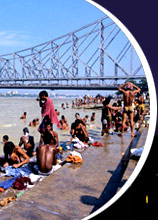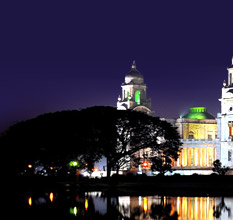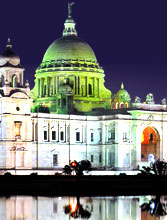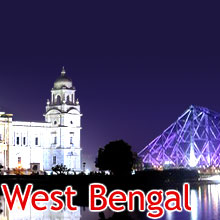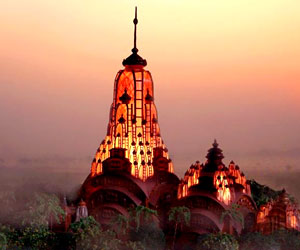 West Bengal, situated in Eastern India, is one of the major states in the country. When we talk about the history of Bengal, we cannot consider West Bengal in isolation. It will comprise of origin of Bengal as a whole, including West Bengal and East Bengal (now Bangladesh). Bengal territory has been an important region since ancient times. The first mention of this province can be found in the great epic of Mahabharata. Due to its strategic location by the sea, different sects of people came and established here, including Aryans in the post-Vedic period. Thus, today, it demonstrates a prolific mixture of five distinct racial strains.
West Bengal, situated in Eastern India, is one of the major states in the country. When we talk about the history of Bengal, we cannot consider West Bengal in isolation. It will comprise of origin of Bengal as a whole, including West Bengal and East Bengal (now Bangladesh). Bengal territory has been an important region since ancient times. The first mention of this province can be found in the great epic of Mahabharata. Due to its strategic location by the sea, different sects of people came and established here, including Aryans in the post-Vedic period. Thus, today, it demonstrates a prolific mixture of five distinct racial strains.Different dynasties, right from the Palas to the Guptas and the Sena, have ruled over the territory of Bengal. Thereafter, it was the time of the Muslim reign, which began with Qutub-ud-in Aibak and ended only after the Battle of Plassey. Then, came the British. The 200-year long tryst of Bengal with British left some inextricable influences on the culture of the state. After gaining independence in 1947, India retained West Bengal, while East Bengal became a part of the Pakistani territory. Today, East Bengal has formed itself into an independent state, called Bangladesh, and West Bengal is a part of the Republic of India.
The Complete History
Ancient Bengal
The earliest mention of Bengal can be found in the old epic of Mahabharta, as 'Vanga'. At that time, the territory was divided into smaller kingdoms and was ruled by chieftains. As per the ancient records in Vedic literature, it was inhabited by several groups of people, belonging to various races. The original inhabitants of Bengal were not Aryans, rather Dravidians (most probably). The Aryans came to Bengal after the Vedic period. It is assumed that the Brahmins and other high castes of Bengal were the descendants of the Aryan invaders, who forced their culture upon the primitive barbarian tribes of Bengal.
Medieval Bengal
Many dynasties exercised their control over Bengal when monarchy came in fashion in India. In about 3rd century, Mauryas and Guptas established their rule in Bengal. The establishment of Gupta Empire marked the end of all small kingdoms that flourished in Bengal, ruled by tribal chiefs. The Palas followed the Guptas and established their strong rule in the territory, from about 800 AD till the 11th century, after which the Senas overtook the Empire of Bengal. Sena Dynasty lost the kingdom of Bengal to Qutub-Ud-In-Aibak, the Sultan of Delhi, in the beginning of 13th century.
After being a part of Delhi Sultanate, the region of Bengal came under the Mughals. The tryst of Bengal with Muslim culture started with this phase only. As an influence of the Muslim culture, conversions began to take place in the state and it also witnessed the development of art, culture and cottage industries. Production of items like muslin brought Bengal to limelight, as they were in great demand in other parts of the world. This phase of Muslim reign surely left an everlasting impact on Bengali culture.
Modern Bengal
The modern history of Bengal can be traced back to the late 17th century, when foreign influences started disturbing the traditional monarchy of the state. Portuguese, Dutch, Danish French and British influence, all began in 17th century only, when Bengal gained prominence in the world, mainly due to its growing textile market and strategic location. The British came to Bengal in 1690, as traders, and extended their grip over the entire state, in about 60 years. On the other hand, Mughal dynasty began losing their grip over the state.
The Battle of Plassey, in 1757, officially exposed the loosened grip of Muslim rulers on Bengal, when Siraj-ud-daul, the last independent ruler of Bengal, was defeated by the British. Bengal was officially made a part of British Empire in 1764, after the battle of Buxar. East India Company, then, fixed a Subedar of the state and acquired administrial as well as financial power. This was the point from where the actual colonization of India began. Calcutta was officially made the capital of India in 1772. The phase of Bengal Renaissance and Brahmo Samaj socio-cultural reform movements also began in this phase.
The first Indian struggle for Independence (Sepoy Mutiny) started near Calcutta, in 1857, and resulted in transfer of authority, from the East India Company, to the British Crown. In 1905, the British partitioned Bengal on the lines of religion. This was the phase when discontentment began in the state, which led to its strong involvement in the freedom struggle. In 1911, the capital of India was shifted from Calcutta to Delhi. In 1947, when India gained independence, Bengal was divided between India and Pakistan. The Hindu-dominated West Bengal was given to India and the Muslim-dominated East Bengal went with Pakistan.
West Bengal became the witness of one of the worst religious riots after independence. Between 1960 and 1970, severe power shortages, strikes and a violent Marxist-Naxalite movement destroyed much of the state's infrastructure, causing a prolonged phase of economic stagnancy. In 1977, the leftist group (Marxist) of India gained a grip over West Bengal's political scenario, leading to stability in the state. The economy of West Bengal further gathered pace after the LPG economic reforms were introduced in India, in 1991. Today, West Bengal is regarded as one of the most developed states in India.

